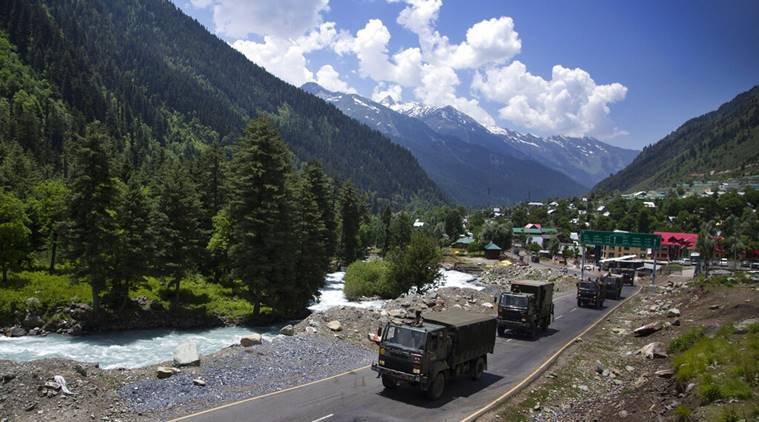Why high altitude warfare is challenging, how soldiers retrained

THE VIOLENT standoff between Indian and Chinese troops in the Galway Valley of the Ladakh region has thrown the spotlight on high-altitude warfare and the challenges that troops face, particularly when advantageous positions on the heights are occupied by the other side.
How is high-altitude warfare fought?
High altitude warfare is fought keeping the terrain and weather in mind. The kind of infrastructure and training that the troops require for high-altitude warfare are key factors. The evolution of such warfare goes back a long way: European countries had mountain brigades in view of the kind of terrain prevalent in those countries. The harshness of the terrain calls for a specialized kind of training to prepare soldiers in terms of mindset and acclimatization.
“To begin with, the troops are imparted training in basic and advance training in mountaineering to make them equipped for mountain warfare “ said Kargil veteran and Maha Vir Chakra awardee Col Sonam Wangchuk, who is based in Leh. High altitude warfare
How is India equipped in such warfare?
Generally, India is considered a hub of mountain warfare skills since most of the country’s north and northeast require such skills. Ladakh Scouts are considered the best in this kind of warfare, Mountain chop, a tactic involved in such warfare, evolved in India where the mountainous terrain is very difficult to scale.
Colonel Sonam said: “The mindset of the enemy sitting above needs to be assessed. Taking stock of the entire situation, one needs to find out the easiest approaches. Especially when there are vertical cliffs, it is generally perceived that the enemy that has taken defensive positions will be less guarded from the side of difficult approaches… Basically. The most difficult approaches where the enemy is likely to give the least resistance need to be used efficiently”.
What are the challenges involved in warfare in a high-altitude place like Galway Valley?
A big factor is who has taken defensive positions and who is sitting on higher ground. Once troops are sitting on high ground, it becomes very difficult to dislodge them from there. In a place like Galway Valley, which is absolutely barren, there is not much concealment. The soldier on high ground is absolutely stationary, which makes those on lower terrain easy targets; the enemy can pick them up one by one. Normally in mountain warfare, troops on the lower ground use a combat ratio of 1: 6, but in circumstances as in Galway. It may go up to 1: 10.
Generally, mountain warfare is fought using the period of darkness to reach the opposing army, engage and overpower them before the first light of day. In case troops do not have the capabilities, fitness, or strategies to do so before dawn, then it is a lost cause. Col Sonam said, “Local troops in Kargil proved fantastic since they were fantastic mountain climbers. But without adequately trained troops who are well–versed with the terrain and are properly acclimatized, it is not an easy game”.
What are the other challenges faced by soldiers in high latitudes?
The first major factor is acclimatization since the oxygen supply reduces drastically. Next, the load-carrying capacity of individuals reduces drastically. Things move very slowly in the mountains and mobilization of troops consumes time. Thus, time and place need to be kept on top priority when deciding where the troops have to be stationed and how they have to be mobilized.
At every stage when an assault progresses. The troops require access to maintenance. One needs to identify tactical points (which are passes in the current scenario) where troops can build roads and take defensive positions, and where those troops can last for 48 – 72 hours. But then constant supplies are required to reach them. Generally, troops carry a 30 – 35 kg load including weapons, ammunition, communication equipment, rations, etc. It is difficult to negotiate such terrains etc. It is difficult to negotiate such terrains carrying such loads; it is difficult even to raise one’s hand.





What are the logistical challenges in this kind of warfare?
One major challenge is that weapons jam, particularly in high–altitude areas. When a soldier is at a height of 17,000 ft or above, it is very cold, and he needs to grease the weapons and clean the barrels at least once a week to ensure they function efficiently. But at the time of combat, this becomes difficult. High altitude warfare
Vehicles do not start when fuel jams. If the fuel is diesel. It won’t ignite unless it is mixed with thinners or other chemicals to make them thin enough to fire the engine. Planning has to be done in advance, with recces carried out, which again is difficult in the mountains. There has to be a contingency plan to first identify the tactical points that need to be used in case of an assault. High altitude warfare
In Galway, which is an extremely tactical area and strategically important, reinforcement plays a vital role, particularly when the Indian troops are not in a position of advantage. For communication equipment, troops need to carry more batteries because they drain very quickly at high altitudes.
While a battery tends to last for 24 hours in the plains, it will drain in 1 – 2 hours in these severely cold areas. Transporting animals such as mules need to be used to maintain adequate supplies, which is not an easy task. Weather constraints play a major factor. High altitude warfare
What kind of training do Indian troops get in mountain warfare?
First, the troops are trained in skilled mountaineering techniques, rock – craft as well as mountain craft. Col Sonam said, “Generally, soldiers of the unit that is going to be inducted get month-long training. It’s concerted training with the best instructors placed in every unit. The training continues whenever the units are inducted. Then comes the casualties. Almost all units have these trainers who keep troops well – equipped a
